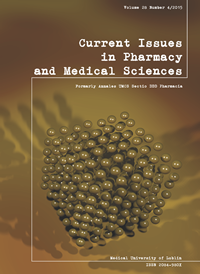The effect of short-term lithium treatment on head twitches induced by 5-hydroxytryptophan in mice
DOI:
https://doi.org/10.1515/cipms-2015-0086Keywords:
lithium, serotonin, head twitches, miceAbstract
The effectiveness of lithium in the treatment of affective disorders is well documented. However, the mechanism of this effect is still unknown. The purpose of this study was to investigate the effect of lithium on serotonergic neurons. The evaluation of the serotoninergic system activity was performed on the basis of an experimental model of head twitch response triggered by direct or indirect stimulation of serotonin 5-HT2 receptors in the brain. The obtained results indicated that the lithium chloride co-applied with a direct precursor of serotonin - 5-hydroxytryptophan used in a threshold dose and with carbidopa, generated head twitch response in mice. What is more, an enhancement of head twitch response in mice was observed after repeated 5-hydroxytryptophan application in head twitch-evoking doses. Moreover, inhibition of the serotonine storage in nerve endings in mice was evoked by reserpine administration. Furthermore, lithium increased the effect of 5-hydroxytryptophan given in a threshold dose and a head twitchevoking dose, respectively. In addition, when P-chlorphenylalanine (pCPA), an inhibitor of the serotonin synthesis within the serotonergic neurons, was given simultaneously with the lithium chloride, carbidopa and 5-hydroxytryptophan in the threshold dose, as well as with the lithium chloride and 5-hydroxytryptophan given at head twitchevoking dosage, pCPA administration decreased the number of head twitches responses in both experimental models, as well as in the reserpinized mice subjected to the lithium chloride and 5-hydroxytryptophan application. Finally, 5,7-dihydroxytryptamineevoked serotoninergic nerve endings destruction led to absolute inhibition of headtwitch response when observed after the lithium and 5-hydroxytryptophan application. Moreover, the increase by lithium 5-hydroxytryptophan-evoke head twitch response was inhibited by administration of the ritanserine - a 5-HT2 serotonin receptor blocking agent.In summary, our data show that lithium induced an enhancement of serotonergic neurotransmission due to its action on presynaptic serotonergic terminals.
References
1. Bauer M. et al.: Lithium augmentation therapy in refractory depression: clinical evidence and neurobiological mechanisms. Can. J .Psychiatry, 48(7), 440, 2003.
2. Berggren U.: Effects of short-term lithium administration on tryptophan levels and 5- hydroxytryptamine synthesis in whole brain and brain regions in rats. J. Neural. Transm., 69, 115, 1987.
3. Blier P., deMontigny C.: Short-term lithium administration enhances serotonergic neurotransmission: electrophysiological evidence in the rat CNS. Eur. J. Pharmacol., 113, 69, 1985.
4. Darmani N.A.: Cannabinoids of diverse structure inhibit two DOIinduced 5-HT(2A) receptor-mediated behaviors in mice. Pharmacol. Bioch. Beh., 68(2), 311, 2001.
5. Fletcher P.J., Korth K.M., Chambers J.W.: Selective destruction of brain serotonin neurons by 5,7-dihydroxytryptamine increases responding for a conditioned reward. Psychopharmacol., 147, 291, 1999.
6. Granoff M.I., Ashby C.R.: The effect of the repeated administration of the compound 3,4-metylenedioxymethamphetamine on the response of rats to the 5-HT2A,C receptor agonist (+/-)-1-(2,5-dimethoxy-4- iodophenyl)-2-aminopropane (DOI). Neuropsychobiol., 37, 36, 1998.
7. Heal D.J. et al.: The influence of central noradrenergic function on 5-HT2-mediated head-twitch response in mice: possible implications for the actions of antidepressant drugs. Psychopharmacol., 89, 414, 1986.
8. Herrero E. et al.: Tryptophan transport into plasma membrane vesicles derived from rat brain synpatosomes. J. Neurochem., 40, 332, 1983.
9. Hotta I., Yamawaki S.: Possible involvement of presynaptic 5-HT autoreceptors in effect of lithium on 5-HT release in hippocampus of rat. Neuropsychopharmacol., 27, 987, 1988.
10. Kofman O., Patishi Y.: Interactions of lithium and drugs that effect signal transduction on behaviour in rats. Eur. Neuropsychopharmacol., 9, 385, 1999.
11. Kuhn D.M., Wolf W.A., Youdim M.B.H.: 5-Hydroxytryptamine release in vivo from a cytoplasmic pool: studies on the 5-HT behavioural syndrome in reserpinized rats. Br. J. Pharmacol., 84, 121, 1985.
12. Licht R.W.: Lithium: still a major option in the management of bipolar disorder. CNS Neuroscience Therpeutics, 18, 219, 2012.
13. Matsumoto K. et al.: α2-adrenoceptor antagonists reverse the 5-HT2 receptor antagonist suppresion of head-twitch behavior in mice. Pharmacol. Bioch. Behav., 56, 417, 1997.
14. McDonald L.M. et al.: Enhancement of latent inhibition by two 5-HT2A receptor antagonists only when given at both pre-exposure and conditioning. Psychopharmacol., 169(3-4), 321, 2003.
15. Munoz-Castaneda J.R. et al.: Role of serotonin in cerebral oxidative stress in rats. Acta Neurobiol. Exp., 66, 1, 2006.
16. Swann A.C. et al.: Differential effects of short and long term lithium on tryptophan uptake and serotonergic function in cat brain. Life Sci., 28, 247, 1986.
17. Treiser S.L. et al.: Lithium increases serotonin release and decreases serotonin receptors in the hippocampus. Science, 213, 1529, 1981.
18. Yamada K., Furukawa T.: Serotonergic function in mouse head twitches by lithium and reserpine. Psychopharmacol., 28, 61(3), 255, 1979.
Downloads
Published
Issue
Section
License
Copyright (c) 2015 Authors

This work is licensed under a Creative Commons Attribution-NonCommercial-NoDerivatives 3.0 Unported License.


